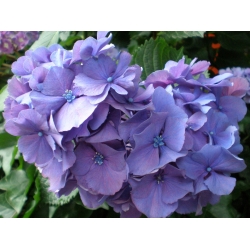Blue Hydrangea
 Click to enlarge |
|
Hydrangea is a genus of about 70-75 species of flowering plants native to southern and eastern Asia (China, Korea, Japan, the Himalayas, and Indonesia) and North and South America. By far the greatest species diversity is in eastern Asia, notably China, Korea, and Japan. Most are shrubs 1-3 m tall, but some are small trees, and others lianas reaching up to 30 m by climbing up trees. They can be either deciduous or evergreen, though the widely cultivated temperate species are all deciduous.
In Korean tea, Hydrangea serrata is used for a herbal tea called sugukcha or ilsulcha. In Japan,ama-cha, meaning sweet tea, is a another herbal tea made from Hydrangea serrata, whose leaves contain a substance that develops a sweet taste (phyllodulcin). For the fullest taste, fresh leaves are crumpled, steamed, and dried, yielding dark brown tea leaves. Ama-cha is mainly used for kan-butsu-e (the Buddha bathing ceremony) on April 8th every year—the day thought to be Buddha's birthday in Japan. Ama-cha is poured over a statue of Buddha in the ceremony and served to people in attendance. A legend has it that on the day Buddha was born, nine dragons poured Amrita over him; ama-cha is substituted for Amrita in Japan.
Your Review: Note: HTML is not translated!
Rating: Bad Good
Enter the code in the box below:





